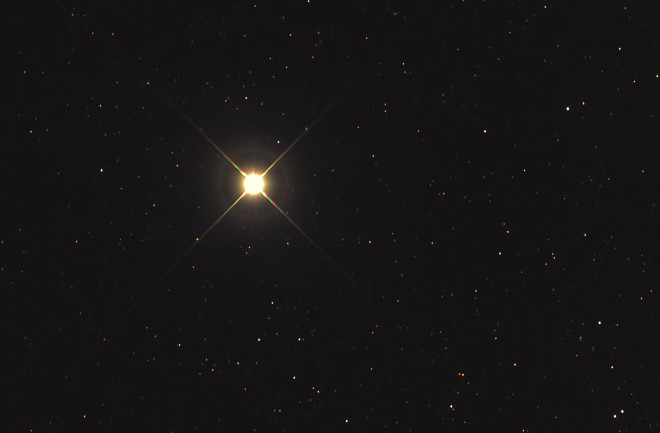Looking up at the night sky can fill you with awe as you sift through the tiny points of light. Some stars are more luminous than others because of their proximity to Earth and the closest stars to Earth will appear the brightest.
In astronomy, brightness is measured in negatives. This means, the larger the number, the dimmer the object. For example, Earth’s moon has a magnitude of -12.6 and our Sun has a magnitude of -26.7. The farthest stars are not seen with the naked eye, but only seen with a space telescope like the Hubble Space Telescope, with a magnitude of over 30.
There are different types of magnitudes but the ones listed below are in apparent magnitude, or how bright a star or other object in the sky looks to someone observing from Earth. This type of magnitude is also called, visual magnitude.
Here are the seven brightest and closest stars seen with the naked eye from Earth and their measurements.
1. Sirius
The brightest star in the sky is Sirius. Known as the north star, Sirius is found in the constellation Canis Major or "Greater Dog," and lines up with the right leg of the constellation Orion. Its name, Greek for sparkling, is fitting for its luminosity.
Even the ancient Egyptians noted the bright star and referred to it as Sothis. Since the star rose a bit before sunrise, around the time the Nile River's annual floods began, they thought the star caused the floods. For the ancient Romans, Sirius represented the hottest part of the year.
As the brightest star in the sky, Sirius has a visual magnitude of -1.46 and is 25.4 times brighter than the sun. It also has a much smaller companion dubbed Sirius B.
Read More: Why Is Space So Dark Even Though The Universe Is Filled With Stars?
2. Canopus
The star Canopus is found in the constellation Carina, which is located 310 light-years from Earth. The Syrian philosopher Poseindonius used the star as a tool to figure out the size of our planet.
It is the second brightest star in the sky with a visual magnitude of -0.74. Canopus isn't seen in the northern latitudes of the United States, so many travel south to see the twinkling star in the Southern Hemisphere.
3. Alpha Centauri
Alpha Centauri is a system of three stars around 25 trillion miles from Earth. The brightest of the three stars, Alpha Centauri A, is like our Sun in size and brightness. The other two are Alpha Centauri B and the red dwarf Proxima Centauri. Together, the trio of stars make up the third brightest stars from Earth. Alpha Centaurus’ brightest star’s visual magnitude is 0.0.
The system is found in the constellation Centaurus and is seen in the southern sky. The Alpha Centauri star system might have the potential to host life and observatories like NASA's Chandra Telescope have been observing it for years.
Read More: What Happens When a Star Dies?
4. Arcturus
Arcturus is the fourth brightest star in Earth's skies and is found in the constellation Boötes. Arcturus is Greek for 'bear guard,' which is fitting because it's located in line with the tail of the constellation Ursa Major, or great bear. Arcturus’ brightness comes in at -0.05 visual magnitude.
With an orange hue, the star is visible to the naked eye. As a red giant, Arcturus is at the end of its life and will eventually transform into a planetary nebula.
5. Vega
Vega is found in the constellation Lyra in the Northern sky. The star is relatively close to our Sun at 25 light-years away. Vega makes part of the 'Summer Triangle' or the three bright stars of other constellations that form a triangle shape. Experts suspect the star sports a ring of dust around its circumference, like the Solar System's icy Kuiper Belt.
It's visible in the Northern Hemisphere at any time of the year for part of the night but is most prominent in the Northern Hemisphere's summer skies. Deneb, Vega, and Altair are the three stars that make up the triangle. Vega has a visual magnitude of 0.03.
6. Capella
Capella appears yellow and is found in the Northern Hemisphere in the constellation Auriga. The name Capella is Latin for she-goat and the star system is about 42.2 light-years from Earth with a visual magnitude of 0.08.
On Earth, Capella looks like one star to the naked eye, but is instead a system of four stars. It consists of a pair of binaries of bright yellow giants dubbed Capella Aa and Capella Ab and another pair of red dwarfs called Capella H and Capella L.
Read More: Why Are There No Green Stars?
7. Rigel
Rigel is found in the constellation Orion or the Huntsman. The star is a blue-white supergiant located 870 light-years away from the Sun. Rigel is Arabic for "the left leg of the giant" and refers to its position as one of Orion's legs.
Within Rigel are three other stars detected only by Earth's giant telescopes. Its blue color means it is hotter than the Sun. Rigel is not as bright as the rest of these stars and has a visual magnitude of 0.12.
Article Sources
Our writers at Discovermagazine.com use peer-reviewed studies and high quality sources for our articles, and our editors review for scientific accuracy and editorial standards. Review the sources used below for this article:
University Lowbrow Astronomers. University Lowbrow Astronomers Naked Eye Observer’s Guide.
Britannica. Sirius.
Britannica. Canopus.
NASA. Alpha Centauri in the constellation of Centaurus (The Centaur).
NASA. Alpha Centauri: A Triple Star System about 4 Light Years from Earth.
Britannica. Arcturus.
NASA. Types of Stars.
Britannica. Vega.
Britannica. Capella.

